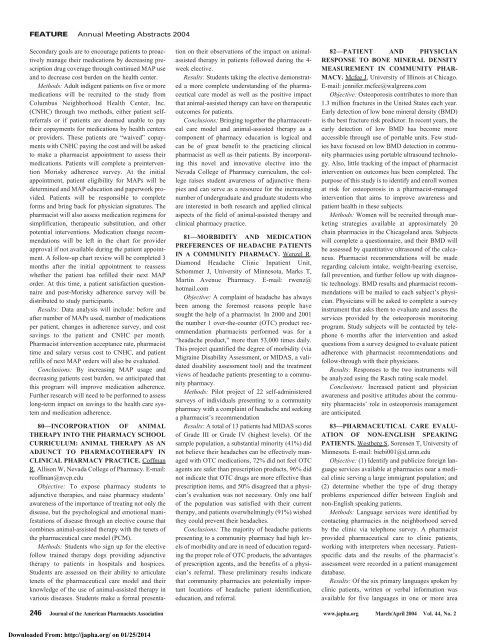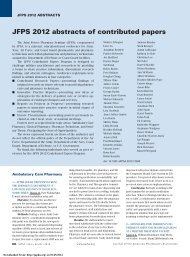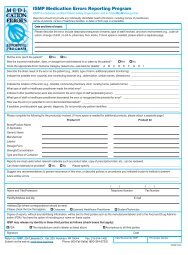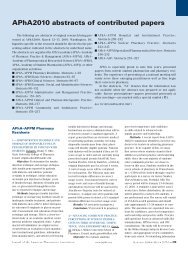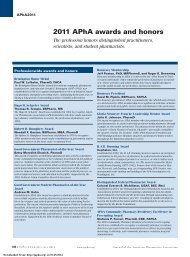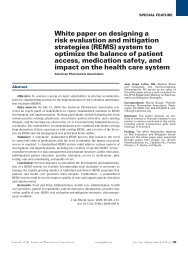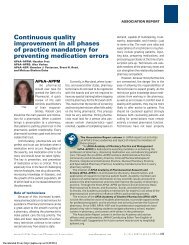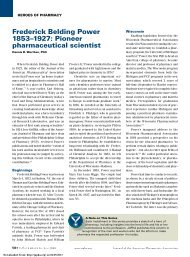Downloaded - Journal of American Pharmacists Association
Downloaded - Journal of American Pharmacists Association
Downloaded - Journal of American Pharmacists Association
Create successful ePaper yourself
Turn your PDF publications into a flip-book with our unique Google optimized e-Paper software.
FEATURE Annual Meeting Abstracts 2004<br />
Secondary goals are to encourage patients to proactively<br />
manage their medications by decreasing prescription<br />
drug coverage through continued MAP use<br />
and to decrease cost burden on the health center.<br />
Methods: Adult indigent patients on five or more<br />
medications will be recruited to the study from<br />
Columbus Neighborhood Health Center, Inc.<br />
(CNHC) through two methods, either patient selfreferrals<br />
or if patients are deemed unable to pay<br />
their copayments for medications by health centers<br />
or providers. These patients are “waived” copayments<br />
with CNHC paying the cost and will be asked<br />
to make a pharmacist appointment to assess their<br />
medications. Patients will complete a preintervention<br />
Morisky adherence survey. At the initial<br />
appointment, patient eligibility for MAPs will be<br />
determined and MAP education and paperwork provided.<br />
Patients will be responsible to complete<br />
forms and bring back for physician signatures. The<br />
pharmacist will also assess medication regimens for<br />
simplification, therapeutic substitution, and other<br />
potential interventions. Medication change recommendations<br />
will be left in the chart for provider<br />
approval if not available during the patient appointment.<br />
A follow-up chart review will be completed 3<br />
months after the initial appointment to reassess<br />
whether the patient has refilled their next MAP<br />
order. At this time, a patient satisfaction questionnaire<br />
and post-Morisky adherence survey will be<br />
distributed to study participants.<br />
Results: Data analysis will include: before and<br />
after number <strong>of</strong> MAPs used, number <strong>of</strong> medications<br />
per patient, changes in adherence survey, and cost<br />
savings to the patient and CNHC per month.<br />
Pharmacist intervention acceptance rate, pharmacist<br />
time and salary versus cost to CNHC, and patient<br />
refills <strong>of</strong> next MAP orders will also be evaluated.<br />
Conclusions: By increasing MAP usage and<br />
decreasing patients cost burden, we anticipated that<br />
this program will improve medication adherence.<br />
Further research will need to be performed to assess<br />
long-term impact on savings to the health care system<br />
and medication adherence.<br />
80—INCORPORATION OF ANIMAL<br />
THERAPY INTO THE PHARMACY SCHOOL<br />
CURRICULUM: ANIMAL THERAPY AS AN<br />
ADJUNCT TO PHARMACOTHERAPY IN<br />
CLINICAL PHARMACY PRACTICE. C<strong>of</strong>fman<br />
R, Allison W, Nevada College <strong>of</strong> Pharmacy. E-mail:<br />
rc<strong>of</strong>fman@nvcp.edu<br />
Objective: To expose pharmacy students to<br />
adjunctive therapies, and raise pharmacy students’<br />
awareness <strong>of</strong> the importance <strong>of</strong> treating not only the<br />
disease, but the psychological and emotional manifestations<br />
<strong>of</strong> disease through an elective course that<br />
combines animal-assisted therapy with the tenets <strong>of</strong><br />
the pharmaceutical care model (PCM).<br />
Methods: Students who sign up for the elective<br />
follow trained therapy dogs providing adjunctive<br />
therapy to patients in hospitals and hospices.<br />
Students are assessed on their ability to articulate<br />
tenets <strong>of</strong> the pharmaceutical care model and their<br />
knowledge <strong>of</strong> the use <strong>of</strong> animal-assisted therapy in<br />
various diseases. Students make a formal presentation<br />
on their observations <strong>of</strong> the impact on animalassisted<br />
therapy in patients followed during the 4-<br />
week elective.<br />
Results: Students taking the elective demonstrated<br />
a more complete understanding <strong>of</strong> the pharmaceutical<br />
care model as well as the positive impact<br />
that animal-assisted therapy can have on therapeutic<br />
outcomes for patients.<br />
Conclusions: Bringing together the pharmaceutical<br />
care model and animal-assisted therapy as a<br />
component <strong>of</strong> pharmacy education is logical and<br />
can be <strong>of</strong> great benefit to the practicing clinical<br />
pharmacist as well as their patients. By incorporating<br />
this novel and innovative elective into the<br />
Nevada College <strong>of</strong> Pharmacy curriculum, the college<br />
raises student awareness <strong>of</strong> adjunctive therapies<br />
and can serve as a resource for the increasing<br />
number <strong>of</strong> undergraduate and graduate students who<br />
are interested in both research and applied clinical<br />
aspects <strong>of</strong> the field <strong>of</strong> animal-assisted therapy and<br />
clinical pharmacy practice.<br />
81—MORBIDITY AND MEDICATION<br />
PREFERENCES OF HEADACHE PATIENTS<br />
IN A COMMUNITY PHARMACY. Wenzel R,<br />
Diamond Headache Clinic Inpatient Unit,<br />
Schommer J, University <strong>of</strong> Minnesota, Marks T,<br />
Martin Avenue Pharmacy. E-mail: rwenz@<br />
hotmail.com<br />
Objective: A complaint <strong>of</strong> headache has always<br />
been among the foremost reasons people have<br />
sought the help <strong>of</strong> a pharmacist. In 2000 and 2001<br />
the number 1 over-the-counter (OTC) product recommendation<br />
pharmacists performed was for a<br />
“headache product,” more than 53,000 times daily.<br />
This project quantified the degree <strong>of</strong> morbidity (via<br />
Migraine Disability Assessment, or MIDAS, a validated<br />
disability assessment tool) and the treatment<br />
views <strong>of</strong> headache patients presenting to a community<br />
pharmacy.<br />
Methods: Pilot project <strong>of</strong> 22 self-administered<br />
surveys <strong>of</strong> individuals presenting to a community<br />
pharmacy with a complaint <strong>of</strong> headache and seeking<br />
a pharmacist’s recommendation<br />
Results: A total <strong>of</strong> 13 patients had MIDAS scores<br />
<strong>of</strong> Grade III or Grade IV (highest levels). Of the<br />
sample population, a substantial minority (41%) did<br />
not believe their headaches can be effectively managed<br />
with OTC medications, 72% did not feel OTC<br />
agents are safer than prescription products, 96% did<br />
not indicate that OTC drugs are more effective than<br />
prescription items, and 50% disagreed that a physician’s<br />
evaluation was not necessary. Only one half<br />
<strong>of</strong> the population was satisfied with their current<br />
therapy, and patients overwhelmingly (91%) wished<br />
they could prevent their headaches.<br />
Conclusions: The majority <strong>of</strong> headache patients<br />
presenting to a community pharmacy had high levels<br />
<strong>of</strong> morbidity and are in need <strong>of</strong> education regarding<br />
the proper role <strong>of</strong> OTC products, the advantages<br />
<strong>of</strong> prescription agents, and the benefits <strong>of</strong> a physician’s<br />
referral. These preliminary results indicate<br />
that community pharmacies are potentially important<br />
locations <strong>of</strong> headache patient identification,<br />
education, and referral.<br />
82—PATIENT AND PHYSICIAN<br />
RESPONSE TO BONE MINERAL DENSITY<br />
MEASUREMENT IN COMMUNITY PHAR-<br />
MACY. Mcfee J, University <strong>of</strong> Illinois at Chicago.<br />
E-mail: jennifer.mcfee@walgreens.com<br />
Objective: Osteoporosis contributes to more than<br />
1.3 million fractures in the United States each year.<br />
Early detection <strong>of</strong> low bone mineral density (BMD)<br />
is the best fracture risk predictor. In recent years, the<br />
early detection <strong>of</strong> low BMD has become more<br />
accessible through use <strong>of</strong> portable units. Few studies<br />
have focused on low BMD detection in community<br />
pharmacies using portable ultrasound technology.<br />
Also, little tracking <strong>of</strong> the impact <strong>of</strong> pharmacist<br />
intervention on outcomes has been completed. The<br />
purpose <strong>of</strong> this study is to identify and enroll women<br />
at risk for osteoporosis in a pharmacist-managed<br />
intervention that aims to improve awareness and<br />
patient health in these subjects.<br />
Methods: Women will be recruited through marketing<br />
strategies available at approximately 20<br />
chain pharmacies in the Chicagoland area. Subjects<br />
will complete a questionnaire, and their BMD will<br />
be assessed by quantitative ultrasound <strong>of</strong> the calcaneus.<br />
Pharmacist recommendations will be made<br />
regarding calcium intake, weight-bearing exercise,<br />
fall prevention, and further follow up with diagnostic<br />
technology. BMD results and pharmacist recommendations<br />
will be mailed to each subject’s physician.<br />
Physicians will be asked to complete a survey<br />
instrument that asks them to evaluate and assess the<br />
services provided by the osteoporosis monitoring<br />
program. Study subjects will be contacted by telephone<br />
6 months after the intervention and asked<br />
questions from a survey designed to evaluate patient<br />
adherence with pharmacist recommendations and<br />
follow-through with their physicians.<br />
Results: Responses to the two instruments will<br />
be analyzed using the Rasch rating scale model.<br />
Conclusions: Increased patient and physician<br />
awareness and positive attitudes about the community<br />
pharmacists’ role in osteoporosis management<br />
are anticipated.<br />
83—PHARMACEUTICAL CARE EVALU-<br />
ATION OF NON-ENGLISH SPEAKING<br />
PATIENTS. Westberg S, Sorensen T, University <strong>of</strong><br />
Minnesota. E-mail: biebi001@d.umn.edu<br />
Objective: (1) Identify and publicize foreign language<br />
services available at pharmacies near a medical<br />
clinic serving a large immigrant population; and<br />
(2) determine whether the type <strong>of</strong> drug therapy<br />
problems experienced differ between English and<br />
non-English speaking patients.<br />
Methods: Language services were identified by<br />
contacting pharmacies in the neighborhood served<br />
by the clinic via telephone survey. A pharmacist<br />
provided pharmaceutical care to clinic patients,<br />
working with interpreters when necessary. Patientspecific<br />
data and the results <strong>of</strong> the pharmacist’s<br />
assessment were recorded in a patient management<br />
database.<br />
Results: Of the six primary languages spoken by<br />
clinic patients, written or verbal information was<br />
available for five languages in one or more area<br />
246 <strong>Journal</strong> <strong>of</strong> the <strong>American</strong> <strong>Pharmacists</strong> <strong>Association</strong> www.japha.org March/April 2004 Vol. 44, No. 2<br />
<strong>Downloaded</strong> From: http://japha.org/ on 01/25/2014


